CUGL-371: Southwest Leadership Semester
Course Code: CUGL-371
Start Date: 3/5/23
End Date: 4/28/23
Located in Outward Bound's most remote course areas in scenic southern Utah, the Southwest Leadership Semester is 55 days of discovery, challenge and compassion. 55 days quickly becomes a lifetime of personal strength, leadership, and friendship
The Southwest Leadership Semester is an exploration of the canyons and whitewater rivers of one of the most geologically stunning landscapes in the entire world. Colorado Outward Bound School semester courses are designed to develop outdoor skills, enhance leadership and communication abilities on course to transfer them home. Outward Bound balances experienced and acquired knowledge. Students learn how to descend narrow obstacle-filled slot canyons, summon the strength to lead while learning to backpack, and charge some of the biggest whitewater in the West. On course you will work for and with your community, learn technical rope systems and whitewater experience, as well as increase your knowledge and awareness of the world around you and yourself. Oh, and having loads of laughs while you’re at it.
Successful completion of your course demands development and mastery of skills, trust, fitness, confidence, tenacity, leadership, initiative, and above all compassion. The promotion of these qualities, and the discovery of what’s within you, is the purpose of Outward Bound.
Utah's Canyon Country
The most spectacular aspects of the Utah landscape are the hidden treasures found within its vast canyon networks. The canyons are composed of a spell-binding labyrinth of towering walls, arches, and slot canyons just waiting to be explored. On course, these vibrant formations are a geological playground for scrambling and teamwork. The desert ecosystem is characterized by aromatic plants like sagebrush and juniper and birds soaring high above canyon walls. The days can be hot in the summertime, but it always cools down in the evenings. These regions are within the ancestral lands of the Ute, Pueblos, Southern Paiute, Diné, and Hopi nations.
Cataract Canyon, Utah
You hear “ALL FORWARD!” shouted above the roar of the rapids by the captain of your raft (that could be you). Next thing you know, you’re digging your paddle blade in deep to meet some of the biggest and best whitewater of the West. One of the most rugged and beautiful canyons in the West, Cataract Canyon takes you through the heart of Canyonlands National Park. You will learn how to guide a whitewater raft as you float past natural wonders and ancient dwellings to the confluence of the Colorado and Green Rivers while preparing for what awaits downstream. The Colorado River roars through 29 exciting rapids that rate with those of the Grand Canyon in power and difficulty, including the famous Mile Long Rapids and “the Big Drops.” In the nearby canyons, fantastic rock shapes carved by the whimsical forces of nature await you as your group ventures off-river to jaw-dropping views. This region is located within the ancestral lands of the Ute nation.
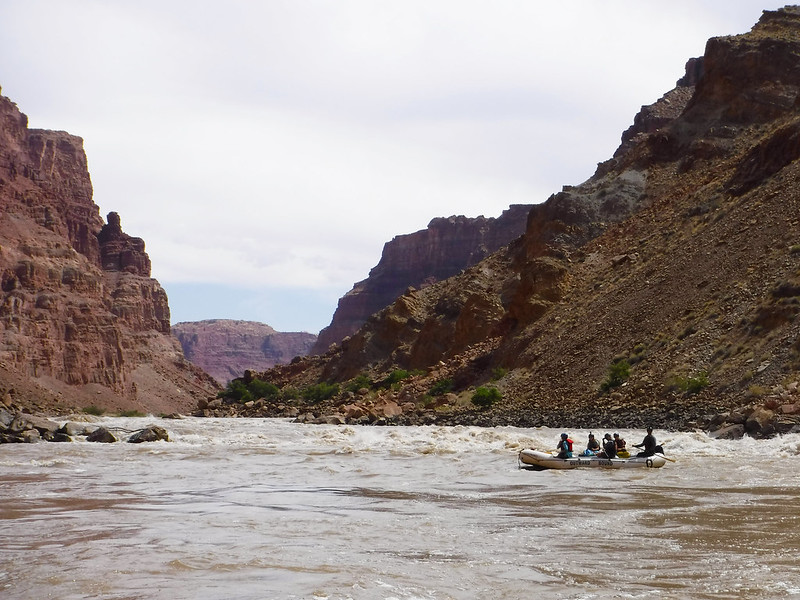
Photo: Olivia Schneider |📍Ute lands
Labyrinth Canyon, Utah
You will launch on the Green River in two-person canoes for 63 miles through Labyrinth Canyon. The river enters Labyrinth Canyon slowly, named for the serpentine path it carves as it dives deep into the redrock sandstone that characterizes southeastern Utah and the Canyonlands area. Narrow and winding side canyons, towering cliffs rising vertically out of the river, pinnacles and ledges all await you as you fine-tune your paddling strokes. The canoes provide you with great freedom and maneuverability. While many of the skills you learn canoeing are transferable to rafts, the small craft will demand a high level of coordination and cooperation with your canoeing partner. During this phase of your course, your instructors will introduce you to the most important elements of river life: environmental stewardship, outdoor cooking, first aid, natural history of the river canyons, the night sky, and of course, paddling skills. This region is within the ancestral lands of the Ute nations.
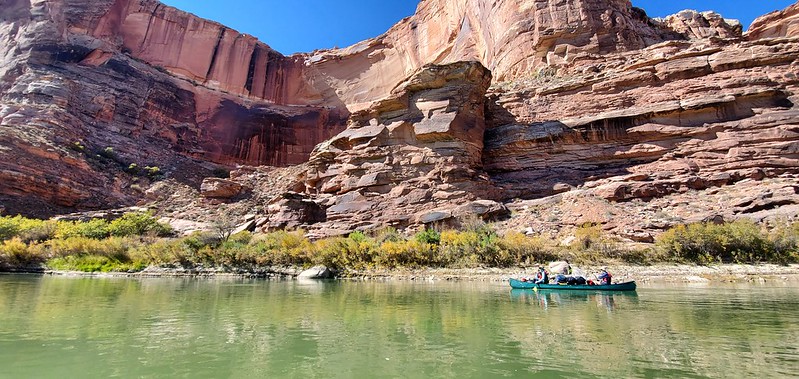
Ute lands
What is a land acknowledgment?
At the Colorado Outward Bound School, we include land acknowledgments in our work as a formal way to recognize and respect the traditional territories and Indigenous Peoples as stewards of the land. It is important to understand and acknowledge the comprehensive past, present, and future of the places we travel and to seek to understand our role therein. To recognize the land is an expression of gratitude and appreciation we give to the Indigenous Peoples who have been living and working on the land from time immemorial. Read more about land acknowledgments at Outward Bound here.
Canyon Backpacking
You will journey through awe-inspiring canyon country by foot, carrying everything you need in your backpack. Days will be spent taking in views of arches and working with your crew to navigate the canyons with a map and compass. You'll camp and cook meals on expansive rock slabs with incredible views of the sunset and the milky way. Sometimes you will shed your backpacks for smaller daypacks to navigate into narrow slots or explore thousand-year-old cliff dwellings and rock art. Over time, as you gain confidence in navigating slick rock obstacles, map reading, and setting up camp, your Instructors will give you and your crewmates more responsibility to chart your own path.
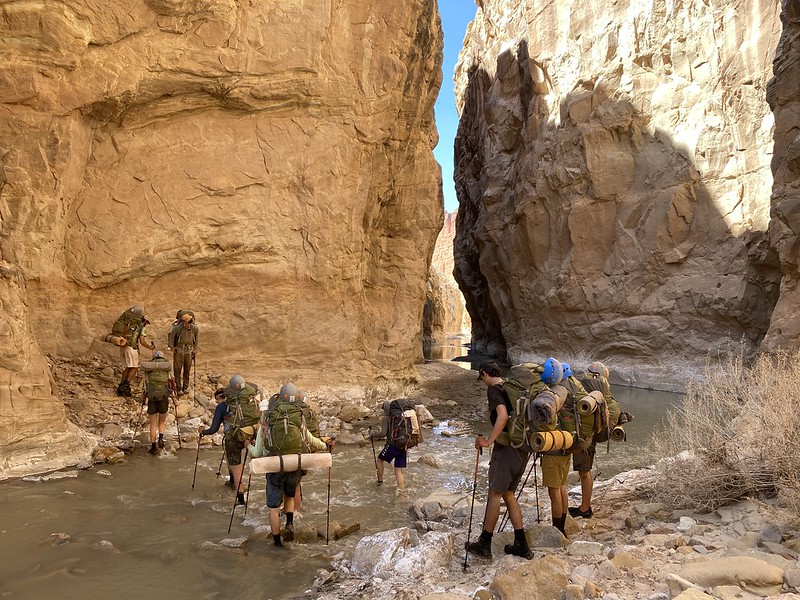
📍Núu-agha-tʉvʉ-pʉ̱ (Ute) lands
Technical Canyoneering
Canyoneering is like playing in the most exciting adventure course imaginable. Each obstacle occurs naturally – formed by thousands of years of wind and water eroding the vibrant layers of rock. A combination of scrambling, hiking, wading through water, and rappelling may be involved during course. As students travel deeper through narrow and winding canyons, sunlight bounces off the walls causing the rock to glow red and orange. Hidden waterfalls and pools can be found, offering an oasis for both students and wildlife. Instructors will teach students how to travel safely and efficiently over rocks and across desert ecosystems. Crews work together, problem-solving and supporting each other as they navigate this dynamic and continuously changing environment.
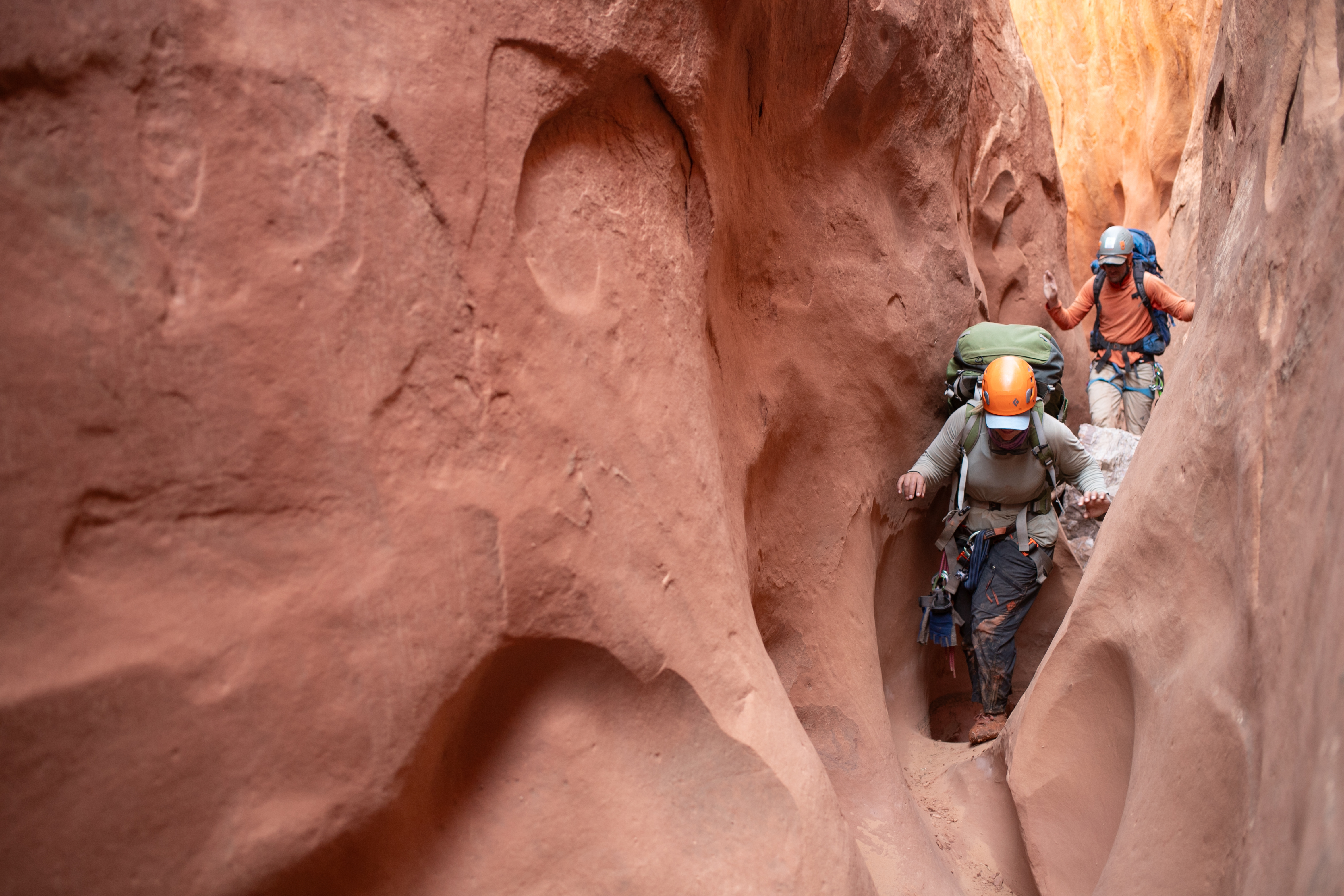
📍Núu-agha-tʉvʉ-pʉ̱ (Ute) lands | PC: Steve Creech
Rafting
On the river, each day is spent learning to navigate various obstacles and how to anticipate the forces of the current from upstream. You and your companions will work to become a team, coordinating your spacing and paddle strokes. You will have an opportunity to be the captain of your crew and put to use what you’ve learned as you maneuver your raft through Class 2-4 rapids. Interspersed between the rapids are flat-water sections where there is a current, but no whitewater. At times, you will take advantage of this calm water to hone your skills and enjoy the view. Time in a raft is ideal for getting to know each other and forming boat pride, laughing your way downriver as you relax into river life. Afternoons can bring strong up-canyon winds, which create a challenge as you dig in to reach the camping destination. Rafting connects you to the river: the oasis of flora and fauna (including humans!) that rely on the river to survive in the desert. The soaring canyons complement the roar of whitewater, as well as the silences that can only be found in such remote beauty.
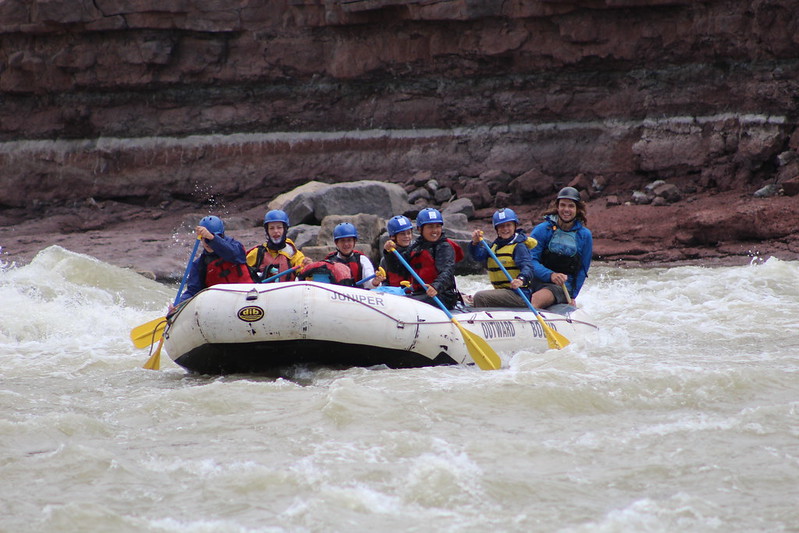
Photo: Curtis Huey |📍Núu-agha-tʉvʉ-pʉ̱ (Ute), Diné, and Pueblos lands
Guided Reflection and Transference
At Outward Bound we believe there is no learning without reflection. Throughout course, you will be prompted to reflect on what you’re experiencing on course, and what it means in the greater context of your life. Sometimes this is a journaling exercise, sometimes a group sharing experience, and sometimes a moment of solitude to sit and think. You spend focused time toward course progression end exploring how your new knowledge, skills and attributes can apply to your life after course.
Solo
Solo is a time when you’ll get the opportunity to spend time alone during course. With sufficient food and equipment, your Solo will be a chance to reflect on your course experience, journal, and connect with nature. Depending on your course length and environmental factors, Solo can range from 30 minutes to an overnight experience. You will not travel during this time and your Instructors may check on you occasionally. Your solo site will be close enough to your Instructors in case of emergency, but far enough removed to enjoy solitude. Many students are initially nervous about solo, but later recall it as one of the highlights of their course.
Wilderness First Aid
Despite the best risk management, sometimes accidents happen, and knowing how to respond to injuries in a backcountry setting is a key skill for aspiring outdoor leaders. During this section, you will spend two days in a classroom at our basecamp, learning about wilderness medicine. You will have the opportunity to earn a Wilderness First Aid (WFA) certification during this course, which is considered a standard for many entry level jobs in the Outdoor Industry.
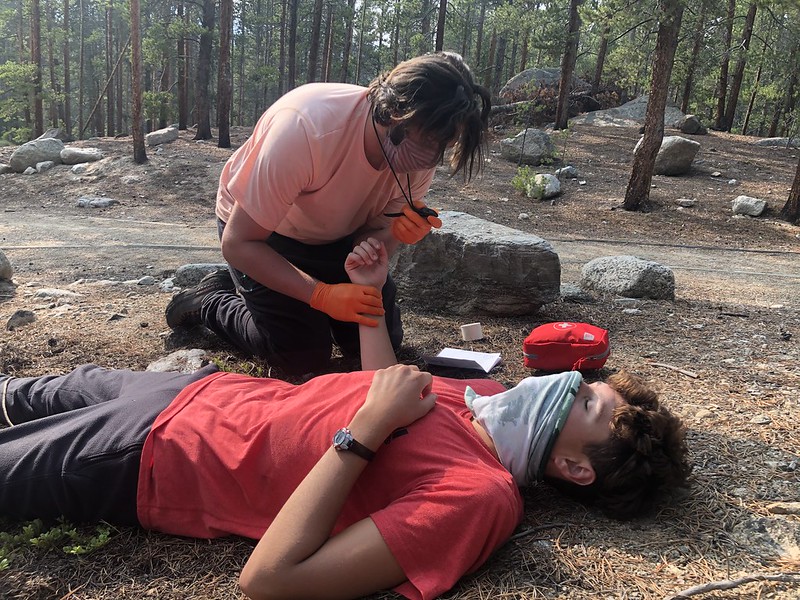
📍Núu-agha-tʉvʉ-pʉ̱ (Ute) lands
Service
Service is a pillar of the Outward Bound experience. On each course, students learn to practice intentional service to themselves, to others and to the environment. This may look like practicing self-care or supporting a crewmate who is having a hard day. Participants also learn to Leave No Trace ethics, practicing service to the environment by preserving and respecting the fragile ecosystems they encounter. Students experience firsthand the social and emotional benefits of acts of service. They are encouraged to bring this ethic of care to their life back home.
Canoeing
Canoeing is an opportunity to experience the jaw-dropping canyons and magic of the river. The tranquil waters allow for reflection and relationship-building with your canoe partner. The calm waters can change with up-canyon winds that require strength to push forward. The canoes provide you with great freedom and maneuverability. While many of the skills you learn canoeing are transferable to rafts, the small craft will demand a high level of coordination and cooperation with your canoeing partner.
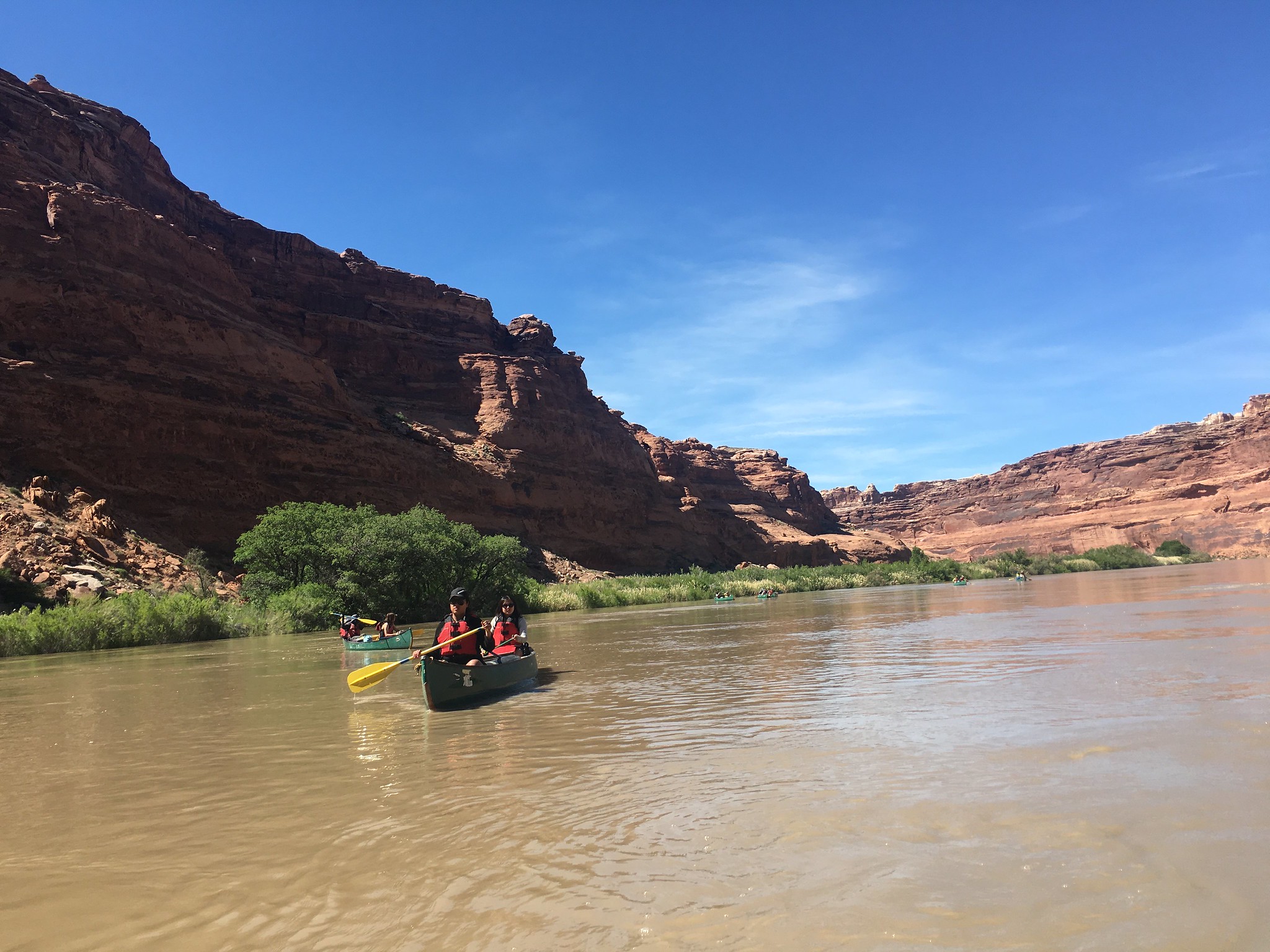
Photo: Ashley Perry |📍Núu-agha-tʉvʉ-pʉ̱ (Ute), Diné, and Pueblos lands
The following is an example of what your itinerary may look like. Your actual course plan will vary according to weather, your group’s skills and abilities, and Instructor preferences.
Day 1: Course Start
Day 2-8: Canyon Backpacking
Day 9-12: Wilderness First Aid Class
Day 13-20: Canoeing
Day 21-29: Rafting Cataract Canyon, Day Hikes
Day 30-45: Transfer to the Canyons: Technical Canyoneering, Slot Canyons, Day Hikes, Solo, Canyon Backpacking
Day 46-53: Canyon Backpacking - Possible Final Expedition
Day 54-55: Final Challenge Event, Course End Ceremonies
Our expeditions help students grow into the best version of themselves. We use adventure in the outdoors to help students discover their strengths and build authentic connections with their peers. Compassion for oneself and others is foundational to the Outward Bound experience. As students develop outdoor skills, they also gain confidence and leadership tools that will last a lifetime. Course outcomes include:
- Belonging – students form deep connections founded upon respect, inclusion, and compassion
- Reflection – students learn self-awareness and practice empathy towards others
- Physical Engagement – students develop awareness and confidence in their bodies
- Courage – students develop the confidence to speak up for themselves and persevere through challenges
Watch to Learn More
Tuition
You can pay your tuition online through your Applicant Portal or make the payment over the phone by calling 720-381-6589.
If your payment is not received by the due date listed in your Enrollment Email and on your Applicant Portal, you will risk losing your spot on course and your $500 deposit. Please review our Admissions and Cancellation Policies.
Travel Insurance
Airfare, travel costs, and non-refundable tuition payments are expensive. Insurance to protect your trip and course is strongly encouraged. We recommend insuring these costs from the third-party provider InsureMyTrip. This provider has coverage options that include travel costs and non-refundable tuition costs. For more information and to receive a free quote, click here.
Click here for COBS COVID-19 Program Practices